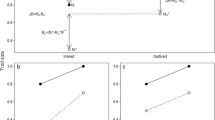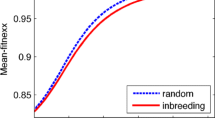The frequency of the black gene increased from 0.25 to over 0.28 in two generations of hybridization of the wild and Chicago Black strains of Tribolium castaneum. Population budgets constructed from census data taken at five-day intervals over both generations reveal marked differences in the mortality schedules of the three genotypes. Selection over a generation is explained as a two-step process involving differential production of bb eggs and high +b survivorship.
Similar content being viewed by others
References
Bryant, E.H. & R.R. Sokal, 1967. The fate of immature housefly populations at low and high densities. Res. Pop. Ecol. 9: 19–44.
Dawson, P.S. 1975. Directional versus stabilizing selection for developmental time in natural and laboratory populations of flour beetles. Genetics 80: 773–783.
Kence, A. 1973. The effects of variation in larval development on laboratory populations of Tribolium and houseflies. Ph.D. Thesis, State University of New York at Stony Brook, 184 p.
Petit, C. & L. Ehrman, 1969. Sexual selection in Drosophila, Evol. Biol. 3: 177–223.
Sokal, R.R. & E.H. Bryant. 1967. Computing a population budget from sequentially sacrificed, replicated cultures. Res. Pop. Ecol. 9: 10–18.
Sokal, R.R. & K. Fulii, 1973. The effects of genetic background on the ecology of selection in Tribolium populations. Evolution, Lancaster, Pa. 26: 489–512.
Sokal, R.R., A. Kence & D.E. McCauley. 1974. The survival of mutants at very low frequencies in Tribolium populations. Genetics 77: 805–818.
Sokal, R.R. & F.J. Sonleitner. 1968. The ecology of selection in hybrid populations of Tribolium castaneum. Ecol. Monogr. 38: 345–479.
Sokoloff, A. 1966. The Genetics of Tribolium and Related Species. Academic Press. New York and London, 212 p.
Wool, D. 1967. Some observations on mating frequeneles in Tribollum castaneum strains. Tribolium Information Bull. 11: 182–186.
Wool, D. 1969. The effect of larval age range on survival of two Tribolium castaneum strains in mixed cultures, through pupal cannibalism. Res. Pop. Ecol. 11: 40–44.
Wool, D. 1970. Deviations of zygotic frequencies from expectations in eggs of Tribolium castaneum. Genetics 66: 115–132.
Author information
Authors and Affiliations
Additional information
Contribution Nr. 147 from the Program in Ecology and Evolution at the State University of New York at Stony Brook. This investigation was supported by grant number BMS 6900343 A04 from the National Science Foundation.
The experiment reported here was initiated and supervised by Dr. Aykut Kence following earlier unpublished work by Dr David Wool. The technical assistance of Meral Kence and Che Nu Paul is much appreciated. Joyce Roe prepared the illustrations.
Rights and permissions
About this article
Cite this article
McCauley, D.E., Sokal, R.R. Fitness components estimated from population budgets of genotypic mixtures and hybrid populations of Tribolium. Genetica 47, 197–202 (1977). https://doi.org/10.1007/BF00123241
Received:
Accepted:
Issue Date:
DOI: https://doi.org/10.1007/BF00123241




